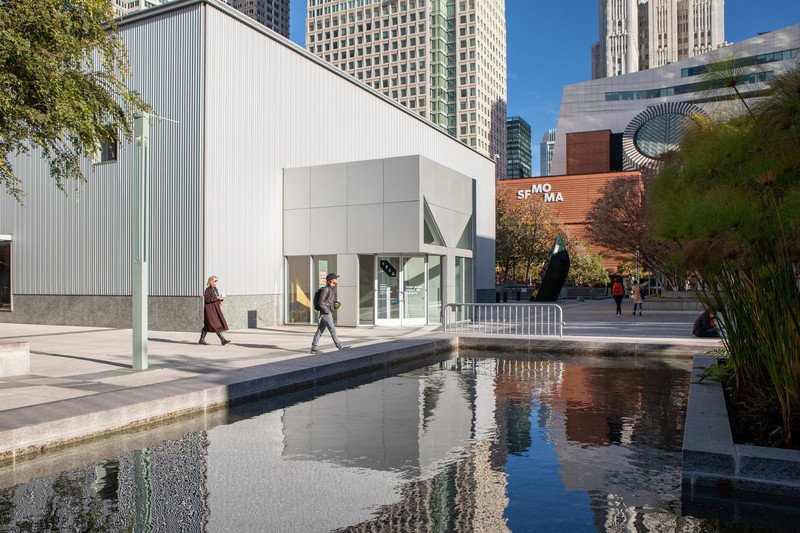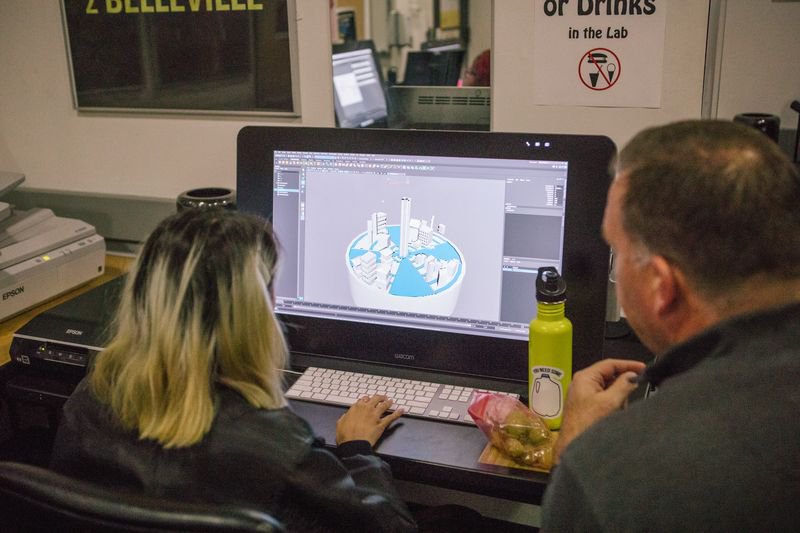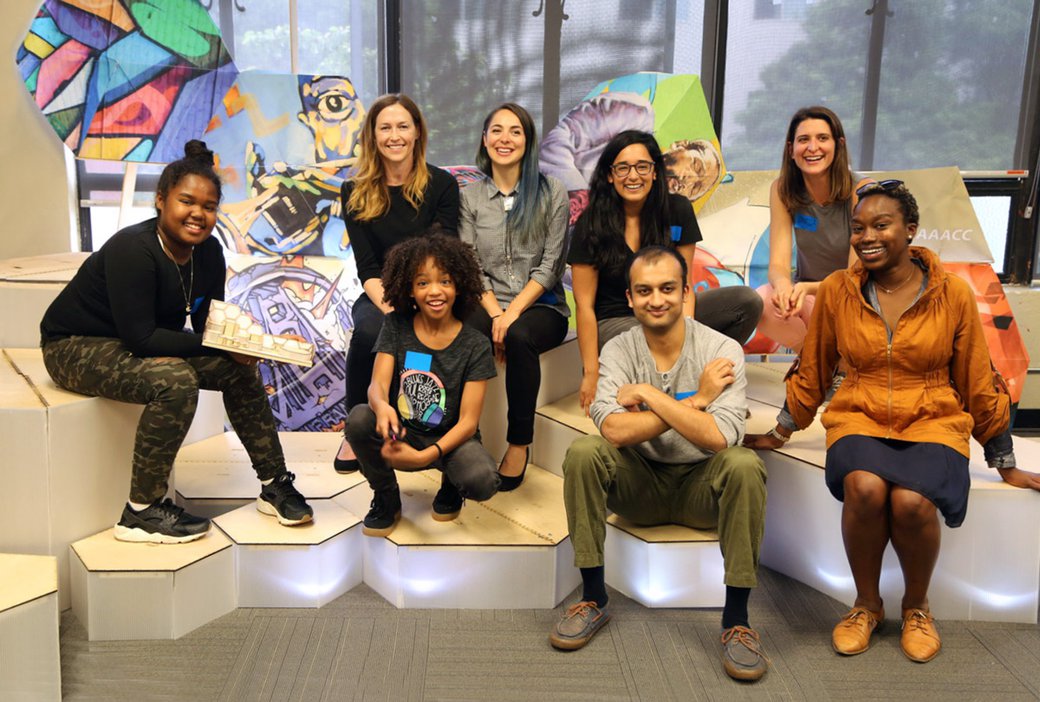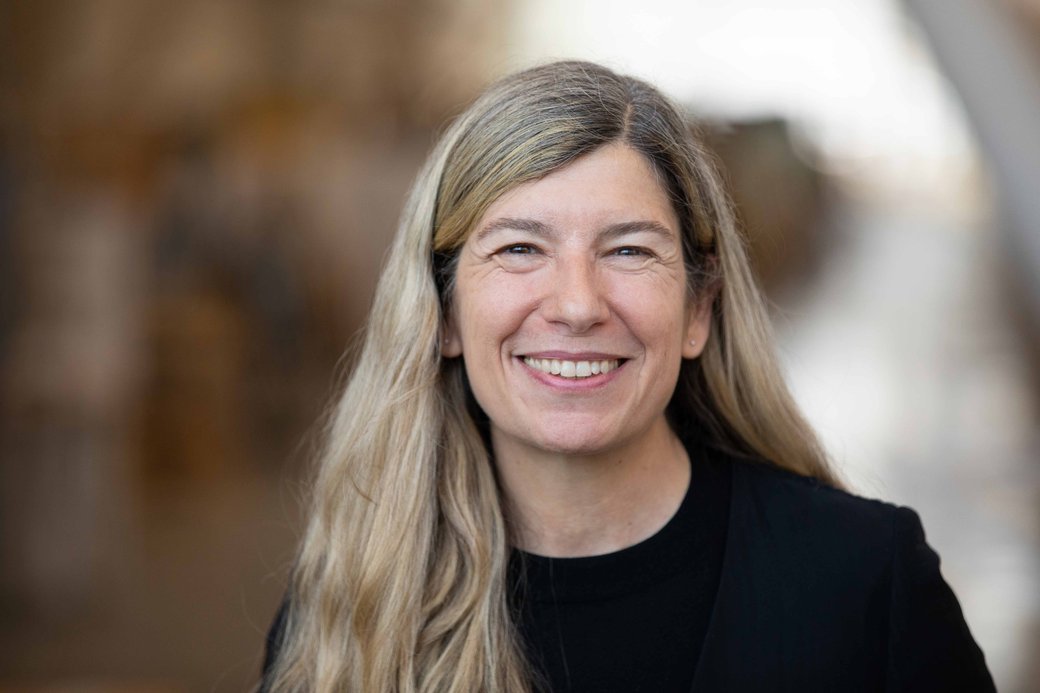
MDesInteraction Design
Overview
Imagine, prototype, and build the future

View of Yerba Buena Center for the Arts and the San Francisco Museum of Modern Art.
Study in the creative capital of Silicon Valley
You’ll be continually inspired by our location in the San Francisco Bay Area, home to leading technology companies, animation and film studios, and groundbreaking art galleries. Graduates of our program have found great success in the many research-driven design practices in the Bay Area and beyond. We’re also in one of the best art and design schools in the world. With a community of fine artists, industrial designers, curators, writers, and other creative practitioners at your fingertips, you’ll find unique ways to make technology meaningful and delightful.
Studios & Shops
Go from concept to final product

You’ll start with foundations, research, and form, and an investigation about the very meaning of language. Then, you’ll build prototypes and envision new systems, and culminate with creating experiences and crafting stories—all the while developing leadership skills by design. Recent student projects evolve beyond speculative design to realize full-scale solutions:
- Wearable air quality monitor
- Smart lock with facial recognition
- Data visualization portal for municipal health trends
- User interface for semi-autonomous vehicles

Design for the greater good
At the heart of our program is a space we call the Social Lab. Each semester, you’ll have the chance to make a positive impact in a community you help define. We partner with arts organizations, bookstores, educational nonprofits, and Bay Area neighborhoods to harness emerging design technologies for the greater good. A recent collaboration with the African American Art & Culture Complex (AAACC), for example, resulted in a beautiful parklet. Co-designed with CCA architecture students, the parklet celebrates and promotes the AAACC’s important mission and unique public programming.
Your MDes IxD experience at CCA
- Master digital prototyping tools
- Explore hierarchy, layout, grid, line, shape, and typography
- Create user scenarios, information flows, and wireframes
- Apply systems thinking to real-world challenges
- Collaborate with arts organizations and nonprofits
- Utilize print, screen, mobile, web, and vehicle canvases
- Experiment with auditory, tactile, and motion inputs
- Study organizational systems and leadership skills
- Design for systems, behavior, and interactive technology
- Create performances, storyboards, and personas
- Learn to pitch design and business concepts
- Build small-scale hypotheses, then at-scale responses
Faculty
Founders and craftspeople
Our faculty are all practicing designers with extensive industry connections. They work for Apple, Microsoft, Facebook, Google, IDEO, and numerous design consultancies in the Bay Area and beyond. Their expertise in user experience design, user interfaces, interactive media, gaming, and service design—just to name a few fields—helps shape our intentional curriculum for future design leaders.

Elena Pacenti, Director of MDes Interaction Design
Elena Pacenti has over three decades of experience leading cutting-edge design research projects and establishing innovative education programs at international design schools.
After earning her PhD research at the Polytechnic University of Milan, she joined Domus Academy, where she directed the Research Center, the Master in Service & Experience Design, and the Design Department. She then established the School of Design at the NewSchool of Architecture & Design in San Diego.
She has also focused much of her career on pioneering work in the field of design for services and advocated for the strategic value of design and the arts in organizations such as Service Design Network, Design Forward, and Future of Design Education.
Curriculum
STEM-designated program
Our intensive one-year, three-semester program is STEM-designated. The coursework emphasizes craft, social impact, and leadership. You’ll learn to address critical, complex challenges through powerful design process skills and intuitive organizational systems. To get a feel for what awaits, view sample courses.
MDes Interaction Design
Fall Semester
- IxD Studio: Foundations
- 3.0 units
- IxD Studio: Design, People, and Society
- 3.0 units
- Communication by Design
- 3.0 units
- IxD Studio: Form
- 3.0 units
Spring Semester
- IxD Studio: Prototyping
- 3.0 units
- IxD Studio: Systems
- 3.0 units
- Social Lab 1
- 3.0 units
- Any Grad-wide elective
- 3.0 units
Summer Semester
- Leadership by Design
- 3.0 units
- IxD Studio: Story
- 3.0 units
- IxD Studio: Experience
- 3.0 units
- Social Lab 2
- 3.0 units
Total 36.0 units
Careers
Make life-changing products and experiences
Our students’ talent for creative, human-centered design sets them up for success in a variety of professional fields. Hands-on experience in the Social Lab gives them the practical skills they need to leverage design for social impact. Our alumni develop augmented reality interfaces for surgeons, design semi-autonomous electric cars, and make apps that help people overcome addiction. Wherever they are in the world, they make an impact through elegant, ethical, and sustainable design practices.
Alumni success

Five questions with Purna Mehta
Senior Product Manager at Redis applies design thinking to cloud-native data products, sharing insights on creative problem-solving and exploring how Redis can power next-generation AI applications with agentic memory and real-time intelligence.

Alum spotlight: Designer and educator Kristine Yuen
Kristine Yuen (MDes Interaction Design 2016) reflects on her user-centric design approach and motivation to mentor aspiring young designers.

Changing careers to become an interaction designer
News & Events
What’s happening in the design community?

MDes Social Lab turns 10
Celebrating 10 years of student-led design projects addressing social/environmental challenges through partnerships with organizations

CCA welcomes new Director of MDes Interaction Design Elena Pacenti
Elena Pacenti takes the helm of the college’s MDes in Interaction Design program with decades of experience building on innovative research, establishing new academic programs, and mentoring the next generation of designers.

Five reasons a STEM-designated program at an art school might be right for you
Combine art and design with technology and science to impact change and grow your career in CCA’s STEM-designated graduate programs.
How to apply
Gather your strongest work for your application
The MDes in Interaction Design is an intensive one-year, three-semester program. We welcome students of all ages and backgrounds who are collaborative systems thinkers and aspiring design leaders. Many of our applicants have five to seven years of professional experience and are ready to take their careers in new directions. Admission to our program is based on the strength of personal essay responses, portfolio submissions, transcripts, and recommendation letters.
The MDes program develops craft, collaboration, and leadership skills through concentrated teamwork. Students spend a significant amount of time making, reading, writing, presenting, and working on interpersonal communication. We look for evidence of your capacity to engage fully with these requirements in your essays, resume, and recommendation letters.
Start your application
You’ll apply to CCA and submit all required application materials via SlideRoom. Afterward, you may be contacted for an interview with a faculty member as part of the application process. Being selected for an interview doesn’t indicate applicant status or increase or decrease an applicant’s chances of being admitted into their desired graduate program. Interviews are conducted at the program’s discretion and are used to gain more insight into an application.
MDes application requirements
- Application and $70 nonrefundable application fee
To be completed and submitted on SlideRoom. - Resume/curriculum vitae
Please outline your educational and professional background and relevant experiences and activities, including community work. Resumes/CVs must be in PDF document format. - Two recommendation letters
You’ll request two letters of recommendation from academic or professional sources in SlideRoom by entering the contact information for your recommenders/references. They will then receive an automated email from SlideRoom with instructions for uploading their letter of recommendation. - Unofficial college transcripts
You are required to provide your complete undergraduate academic history. Students who have already taken graduate courses are encouraged to submit those transcripts, too. For international applicants, all transcripts must be in English or accompanied by a certified English translation.
Please provide an unofficial transcript from the college where you will receive or have received your bachelor’s degree, as well as unofficial transcripts for all other undergraduate coursework. Unofficial transcripts will be used for review purposes.
Once you have been admitted and enrolled, all students will need to submit official, sealed transcripts showing the completion of a bachelor’s degree to our graduate admissions office by August 1 of the fall semester they begin enrollment at CCA. - Proof of English proficiency (international applicants only)
Review and plan to meet our English proficiency requirements for graduate students. - Personal essay
You’ll answer six open-ended questions, one recorded in video form and four in written form. Answers to each question should aim to be 500 words or less:- What draws you to the field of interaction design at this time? Your answer to this question should be recorded in a video, up to 90 seconds maximum length. Be sure to include your definition of interaction design, and show us your personality in the video.
- The MDes program at CCA helps you develop professional leadership skills. Describe a time when you demonstrated professional leadership in collaboration with others to create change. What did you learn about yourself as a leader in the process?
- The MDes program at CCA collaborates with community partners. What’s your approach to building community or engaging with a specific community? Please provide a specific example, whether it’s informal (e.g., planting trees in your neighborhood) or structured (e.g., ongoing volunteering with a nonprofit or NGO), and describe the outcomes of your work.
- What complex problem or social challenge inspires you to bring your design skills to it? Please describe why you selected this particular challenge and what drives you to propose a solution. How will you know your solution is a success?
- Describe how you’ve overcome a situation in the past by using a mindset of curiosity, framing, iteration, communication, collaboration, and measurement. How did it help you grow?
- What are your expectations of the MDes program and CCA?
- Portfolio
We look for design excellence in your portfolio since the program’s primary emphasis is on design craft skills (not technical skills). Portfolios do not need to be in a specific field; a strong graphic or industrial design portfolio will be looked at more favorably than a weak UX portfolio. We also look for your aptitude in tackling complex challenges and engaging with community, perhaps through volunteer work in nonprofits or exploring how design might better address critical social challenges. In addition to academic and professional work, applicants are encouraged to include personal work.
The portfolio can include up to 25 still images, video, and time-based or interactive media. You may also link to media from YouTube, Vimeo, and SoundCloud. Dimensions for portfolio slide pages/case study pages should not exceed 1920 x 1080 pixels per page, with a minimum 8-point / 10-pixel height type.
Allowed media types:- Images (up to 5 MB each)
- Video (up to 250 MB each)
- Audio (up to 30 MB each)
- PDFs (up to 10 MB each)
- External media from YouTube, Vimeo and SoundCloud
Note: Applicants who wish to submit video or time-based media must submit a 3-minute sample reel. The reel should be labeled clearly with the title, date, running time, and description of the work it contains.
For prospective student inquiries, including questions about the program or how to apply, please contact us

Join one of the most in-demand design fields



